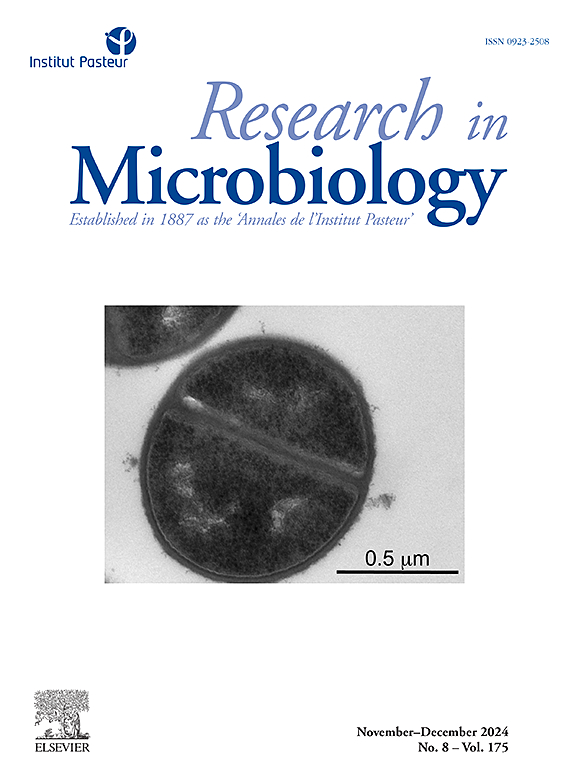进化趋势表明,树液操作子的组织是一致的。
IF 3.4
4区 生物学
Q3 MICROBIOLOGY
引用次数: 0
摘要
人类宿主对微生物病原体具有复杂的免疫反应网络。抗菌肽(AMPs)的产生就是其中一种机制,它以病原体细胞膜为目标,抑制病原体在宿主体内栖息。然而,病原体也进化出了与宿主产生的这些抗菌肽对抗的系统。Sap(对抗菌肽的敏感性)转运体在微生物细胞内吸收 AMPs,并对其进行蛋白分解。Sap 转运体由基因编码的五个亚基组成一个操作子。尽管Sap转运体无处不在,但其亚基在许多生物体内并不串联。本研究共分析了 421 个 Sap 转运体的操作子排列。在 421 个操作子中,发现共有 352 个操作子采用了一致的排列方式,其余 69 个操作子的基因排列方式各不相同。对 sap 操作子亚基间基因距离的分析表明,sapAB(-4)、sapBC(-14)、sapCD(-1)和 sapDF(-4 到 1)是一种特征模式。对这些操作子的进化分析表明,Sap 转运体系统的一致排列方式证明了它在大多数革兰氏阴性病原体中的普遍性。总之,这项研究为细菌进化提供了深入的见解,有利于维持重要致病因子的遗传组织。本文章由计算机程序翻译,如有差异,请以英文原文为准。
Evolutionary trends indicate a coherent organization of sap operons
Human hosts possess a complex network of immune responses against microbial pathogens. The production of antimicrobial peptides (AMPs), which target the pathogen cell membranes and inhibit them from inhabiting the hosts, is one such mechanism. However, pathogens have evolved systems that encounter these host-produced AMPs. The Sap (sensitivity to antimicrobial peptides) transporter uptakes AMPs inside the microbial cell and proteolytically degrades them. The Sap transporters comprise five subunits encoded by genes in an operon. Despite its ubiquitous nature, its subunits are not found to be in tandem with many organisms. In this study, a total of 421 Sap transporters were analyzed for their operonic arrangement. Out of 421, a total of 352 operons were found to be in consensus arrangement, while the remaining 69 show a varying arrangement of genes. The analysis of the intergenic distance between the subunits of the sap operon suggests a signature pattern with sapAB (-4), sapBC (-14), sapCD (-1), and sapDF (-4 to 1). An evolutionary analysis of these operons favors the consensus arrangement of the Sap transporter systems, substantiating its prevalence in most of the Gram-negative pathogens. Overall, this study provides insight into bacterial evolution, favoring the maintenance of the genetic organization of essential pathogenicity factors.
求助全文
通过发布文献求助,成功后即可免费获取论文全文。
去求助
来源期刊

Research in microbiology
生物-微生物学
CiteScore
4.10
自引率
3.80%
发文量
54
审稿时长
16 days
期刊介绍:
Research in Microbiology is the direct descendant of the original Pasteur periodical entitled Annales de l''Institut Pasteur, created in 1887 by Emile Duclaux under the patronage of Louis Pasteur. The Editorial Committee included Chamberland, Grancher, Nocard, Roux and Straus, and the first issue began with Louis Pasteur''s "Lettre sur la Rage" which clearly defines the spirit of the journal:"You have informed me, my dear Duclaux, that you intend to start a monthly collection of articles entitled "Annales de l''Institut Pasteur". You will be rendering a service that will be appreciated by the ever increasing number of young scientists who are attracted to microbiological studies. In your Annales, our laboratory research will of course occupy a central position, but the work from outside groups that you intend to publish will be a source of competitive stimulation for all of us."That first volume included 53 articles as well as critical reviews and book reviews. From that time on, the Annales appeared regularly every month, without interruption, even during the two world wars. Although the journal has undergone many changes over the past 100 years (in the title, the format, the language) reflecting the evolution in scientific publishing, it has consistently maintained the Pasteur tradition by publishing original reports on all aspects of microbiology.
 求助内容:
求助内容: 应助结果提醒方式:
应助结果提醒方式:


